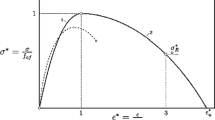Abstract
The results of an experimental investigation are presented, studying the effect of fibres on the behaviour of reinforced-concrete (RC) structures designed in accordance with Eurocode 8. Twelve two-span continuous RC columns, eight with and four without steel fibres, were tested to failure, under constant axial force and monotonic or cyclic lateral displacement. Specimens without fibres suffered in some cases premature brittle failure, reflecting the incompatibility between post-peak concrete behaviour and the theoretical model underlying RC design. It was shown that it is possible to correct for this incompatibility through the use of steel fibres, resulting in a behaviour that satisfied current performance requirements for strength and ductility.
Similar content being viewed by others
References
Kotsovos MD, Pavlovic MN (1999) Ultimate limit-state design of concrete structures: a new approach. Thomas Telford, London, 164~pp
Kotsovos MD (1997) Reply to discussion by Frank Mbakogu to behaviour of structural concrete elements designed to the concept of the compressive-force path by Kotsovos MD, Michelis P (ACI Structural Journal, July-August 1996, p 428). ACI Struct J 94(3): 338–341
Kotsovos MD, Baka A, Vougioukas E (2003) Earthquake-resistant design of reinforced-concrete structures: shortcomings of current methods. ACI Struct J 100(1):11–18
Vougioukas E, Zeris C, Kotsovos MD (2005) Towards a safe and efficient use of FRP for repair and strengthening of RC structures. ACI Struct J 102(4):1–10
Kotsovos GM, Zeris C, Pavlovic MN, Earthquake-resistant design of indeterminate reinforced-concrete slender column elements. Eng Struct (Article in press)
Kotsovos GM, Zeris C, Pavlovic MN, A new methodology for repairing and strengthening RC members in seismic regions. Mag Conc Res 58(2): 63–77
Kotsovos GM, Zeris C, Pavlovic MN (2005) Improving RC seismic design through the CFP method. Proc Inst Civil Eng, Struct & Buildings 158 (SB5): 291–302
Kotsovos MD, Pavlovic MN (2001) The 7/9/99 Athens earthquake: causes of damage not predicted by structural-concrete design methods. Struct Eng 79(15):23–29
Ritter W (1899) Die Bauweise Hennebique. Schweisserische Bauzeitung 33:59–61
Mörsch E (1902) Versuche uber Schubspannungen in Betoneisentragen. Beton und Eisen, Berlin 2(4):269–274
Collins MP, Mitchell D (1980) Shear and torsion design of prestressed and non-prestressed concrete beams. Prestressed Conc Inst 25(5):32–100
Schlaich J, Schafer K, Jennewein M (1987) Toward a consistent design of structural concrete. Prestressed Conc Inst 32(3):74–150
Canadian Standards Assoc (1984) Design of concrete structures for buildings. CAN3-A23.3-M84, 281~pp
Comiteé Europeainne de Normalisation, prEN-1992-1 (2002) Eurocode No. 2. Design of concrete structures. Part 1: General rules and rules of building. Bruxelles
American Concrete Institute (2002) Building code requirements for structural concrete (ACI 318-02) and commentary (ACI 318R-02). Skokie, Illinois
Barnard PR (1964) Researches into the complete stress-strain curve for concrete. Mag Conc Res 16(49):203–210
Fenwick RC, Paulay T (1968) Mechanisms of shear resistance of concrete beams. J Struct Division, ASCE 94(ST10):2325–2350
Taylor HPJ (1974) The fundamental behaviour of reinforced concrete beams in bending and shear. Shear in reinforced concrete, SP-42. American Concrete Institute, Skokie, Illinois, pp 43–77
Taylor HPJ (1969) Investigation of the dowel shear forces carried by tensile steel in reinforced concrete beams. Technical Report 431 (publication 42.431), Cement and Concrete Association, London
Kotsovos MD (1983) Effect of testing techniques on the post-ultimate behaviour of concrete in compression. Mater Struct, RILEM 16(91):3–12
van Mier JGM (1986) Multiaxial strain-softening of concrete. Mater Struct, RILEM 19(111):179–200
van Mier JGM, Shah SP, Arnaud M, Balayssac JP, Bascoul A, Choi S, Dasenbrock D, Ferrara G, French C, Gobbi ME, Karihaloo BL, Konig G, Kotsovos MD, Labuz J, Lange-Kornbak D, Markeset G, Pavlovic MN, Simsch G, Thienel K-C, Turatsinze A, Ulmer U, van Geel HJGM, van Vliet MRA, Zissopoulos D (1997) Strain-softening of concrete in uniaxial compression. Mater Struct, RILEM 30(198):195–209 (Report of the Round Robin Test carried out by RILEM TC 198-SSC: test methods for the strain-softening response of concrete)
Kotsovos MD (1979) Fracture of concrete under generalised stress. Mater Struct, RILEM 12(72):151–158
Kotsovos MD, Newman JB (1981) Fracture mechanics and concrete behaviour. Mag Conc Res 33(115):103–112
Kotsovos MD, Bobrowski J, Eibl J (1987) Behaviour of RC T-beams in shear. Struct Eng 65B(1):1–9
Kotsovos MD (1987) Shear failure of RC beams: a reappraisal of current concepts. CEB Bulletin No. 178/179, pp. 103–111
Kotsovos MD (1987) Consideration of triaxial stress conditions in design: a necessity. ACI Struct J Proc 84(3):266–273
Kotsovos MD (1987) Shear failure of reinforced concrete beams. Eng Struct 9(1):32–38
Jelic I, Pavlovic MN, Kotsovos MD (1999) A study of dowel action in reinforced concrete beams. Mag Conc Res 51(2):131–141
Zisopoulos PM, Pavlovic MN, Kotsovos MD (2004) A contribution to the study of the mechanical properties of plain and fibre-reinforced shotcrete. Conc Eng Int 8(2):44–46
Sharma AK (1986) Shear strength of steel fiber reinforced concrete beams. J ACI, Proc 83(4):624–628
Narayanan R, Darwish I (1987) Use of steel fibers as shear reinforcement. ACI Struct J Proc 84(3):216–227
Ashour SA, Mahmood K, Wafa F (1997) Influence of steel fibers and compression reinforcement on deflection of high-strength concrete beams. ACI Struct J Proc 94(6):611–624
Cho Soon-Ho, Yon-il Kim (2003) Effect of fibers on short beams loaded in shear. ACI Struct J Proc 100(6):765–774
Author information
Authors and Affiliations
Corresponding author
Rights and permissions
About this article
Cite this article
Kotsovos, G., Zeris, C. & Kotsovos, M. The effect of steel fibres on the earthquake-resistant design of reinforced concrete structures. Mater Struct 40, 175–188 (2007). https://doi.org/10.1617/s11527-006-9129-5
Received:
Accepted:
Published:
Issue Date:
DOI: https://doi.org/10.1617/s11527-006-9129-5




